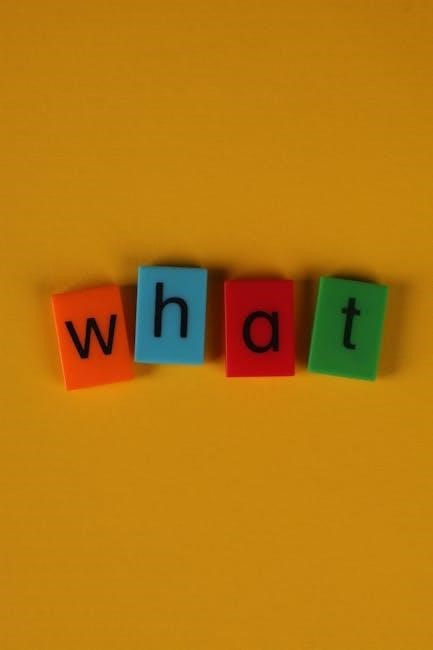Three-syllable words are essential for language development, enhancing reading and speaking skills. They often appear in everyday vocabulary, making them crucial for effective communication and comprehension.
1.1 Definition and Importance
A 3-syllable word is a word that contains three syllables, each consisting of a vowel sound pronounced as a single unit. These words play a vital role in language development, as they help learners expand their vocabulary and improve pronunciation. Syllables are fundamental in understanding rhythm, stress, and intonation in speech. Mastering 3-syllable words enhances reading fluency and comprehension, especially for early learners. They are also common in everyday language, making them essential for effective communication. Recognizing syllable patterns aids in decoding unfamiliar words, a crucial skill for literacy. Thus, understanding and practicing 3-syllable words is a cornerstone of language acquisition and proficiency.
1.2 Common Uses in Language Learning
Three-syllable words are widely used in language learning to build vocabulary and improve phonological awareness. They are often introduced in early education to help learners recognize syllable patterns and enhance reading skills. These words are integral to spelling exercises, as they teach learners to break down words into manageable parts. In pronunciation practice, 3-syllable words help learners master stress and intonation, which are crucial for clear communication. Additionally, they are commonly used in speech therapy to aid individuals in improving articulation and fluency. Overall, 3-syllable words serve as a foundational tool for developing linguistic proficiency and confidence in both native and non-native speakers.

Popular 3-Syllable Word Categories
Three-syllable words are categorized into animal-related, food-related, common nouns, and proper nouns. These categories help learners organize and memorize words effectively for various contexts and applications.
2.1 Animal-Related Words

Animal-related 3-syllable words are a fascinating category, offering a wide range of examples. Words like hummingbird, woodpecker, and butterfly are commonly used. Others include dragonfly, grasshopper, and ladybug. These terms are not only descriptive but also engaging for learners. Many of these words combine elements of nature and behavior, making them memorable. For instance, mosquito and lightning bug describe specific insects with unique characteristics. Even mythical creatures like unicorn and prehistoric animals like dinosaur fall into this category. These words are invaluable for building vocabulary, especially for children and language learners. They also highlight the diversity of life, making them a popular choice in educational materials and activities.
2.2 Food-Related Words
Food-related 3-syllable words are a delicious and practical category for learners. Examples include burrito, lasagna, and applesauce, which are commonly used in everyday conversations. Other tasty options are marshmallows, strawberry, and hamburger. These words are not only fun to say but also relevant for discussions about meals and cuisine. They often appear in educational materials, such as word lists and spelling exercises, making them a great way to expand vocabulary. Additionally, terms like mechanic and buffalo (though not exclusively food-related) are included in broader lists. These words are useful for learners of all ages, helping to connect language with real-life experiences and cultural contexts.
2.3 Common Nouns
Common nouns are everyday words that name people, places, or things. Many 3-syllable common nouns are found in educational resources, such as neighborhood, triangle, and bicycle. These words are often used in spelling lists and language exercises to help learners master pronunciation and syllable division. Other examples include computer, alien, and buffalo, which are familiar and relevant for discussions about daily life. These nouns are essential for building vocabulary and improving reading fluency. They also appear in interactive activities and worksheets, making them a practical choice for language learners of all ages. By practicing these words, learners can enhance their communication skills and understand how syllables contribute to word meaning and structure.
2.4 Proper Nouns
Proper nouns are names of specific, unique entities, such as places, people, or titles. Many 3-syllable proper nouns are found in educational resources, including food-related terms like Lasagna and Marshmallows. Examples like Strawberry and Burrito are also common in word lists. These nouns often appear in spelling exercises and interactive activities, helping learners recognize and pronounce them correctly. Proper nouns like Dinosaur and Unicorn are popular in children’s vocabulary, making them engaging for young learners. Such words are valuable for building familiarity with syllable patterns and improving reading skills. They are frequently included in PDF worksheets and language games, making them accessible for practice and reinforcement.

Examples of 3-Syllable Words

Examples include butterfly, neighborhood, and library. Words like hospital and another are also common, showcasing diverse uses in vocabulary and language learning materials.

3.1 Verbs
Verbs with three syllables are dynamic and commonly used in everyday language. Examples include celebrate (ce-le-brate), decorate (de-co-rate), and generate (gen-er-ate). These verbs often end with suffixes like -ate or -ite, which naturally create multiple syllables. Other examples are terminate (ter-mi-nate) and consider (con-sid-er). Verbs like emphasize (em-pha-size) and authorize (au-tho-rize) are also frequently found in language learning materials. These verbs are essential for constructing clear and expressive sentences, making them a focus in vocabulary development. They often appear in educational resources and practice exercises due to their complexity and usage in various contexts. Mastering these verbs enhances both spoken and written communication skills, particularly for language learners at intermediate levels. Regular practice with these verbs helps improve pronunciation and fluency in speech. They are also used in creative writing and storytelling to convey detailed actions and emotions effectively.
3.2 Adjectives

Three-syllable adjectives add depth and precision to descriptions. Examples include beautiful (beau-ti-ful), comfortable (com-for-table), and decisive (de-ci-sive). These adjectives often end with suffixes like -ful, -less, or -able, which contribute to their syllabic structure. Other examples are generous (gen-er-ous) and harmonious (har-mo-nious). Adjectives like vibrant (vib-rant) and elegant (e-le-gant) are also commonly used. These words are essential for enhancing descriptive language and are frequently included in educational resources. They appear in vocabulary lists and practice exercises to aid language learners in expanding their descriptive capabilities. Understanding and using these adjectives effectively can greatly improve both written and spoken communication, making them a valuable part of vocabulary development. Regular practice helps in mastering their pronunciation and correct usage in various contexts.
3.3 Abstract Nouns
Three-syllable abstract nouns convey complex ideas and emotions, such as harmony (har-mo-ny), generosity (gen-er-os-i-ty), and creativity (cre-a-tiv-i-ty). These nouns often express intangible concepts like freedom (free-dom) or happiness (hap-pi-ness). Words like curiosity (cu-ri-os-i-ty) and simplicity (sim-ple-ci-ty) also fall into this category. Abstract nouns are vital for describing feelings, states, and abstract ideas. They are commonly found in educational resources and vocabulary lists. Learning these words helps language learners express nuanced thoughts and emotions. Regular practice with these nouns enhances understanding and usage in both written and spoken contexts. They are essential for building a rich and expressive vocabulary, making them a key focus in language education and development.
Educational Resources
Printable worksheets and interactive activities provide effective tools for learning and practicing three-syllable words. Resources like PDF lists and online exercises enhance vocabulary building and retention;
4.1 Printable Worksheets
Printable worksheets are an excellent way to practice and master three-syllable words. Many resources, such as those from LessonPix.com, offer 20 picture cards with text, featuring words like hummingbird, woodpecker, and butterfly. These worksheets are ideal for classroom or home use, providing visual and tactile learning opportunities. SpeechTeammate.com also provides worksheets with lists of words like neighborhood, triangle, and bicycle, helping students recognize and spell multisyllabic words. Additionally, ABCmouse.com offers printable activities that include spelling exercises and games. These resources are designed to engage students, improve retention, and make learning fun. Educators can easily incorporate them into lesson plans or use them for homework. Printable worksheets are a practical and effective tool for teaching three-syllable words.
4.2 Interactive Activities
Interactive activities are a dynamic way to engage with three-syllable words, making learning more enjoyable and effective. Online games, audio clips, and quizzes are popular tools that help students practice pronunciation and recognition. Websites like LessonPix.com and ABCmouse.com offer interactive flashcards and word-building puzzles that focus on multisyllabic words. These activities often include visual and auditory elements, such as pictures and sound clips, to enhance understanding. Additionally, many educational platforms provide interactive exercises where students can drag and drop syllables or match words with their meanings. These hands-on approaches cater to different learning styles, ensuring that learners stay motivated and retain the material effectively. Interactive activities are a valuable complement to traditional teaching methods.

Practice and Application
Engage in spelling exercises with words like “neighborhood” and “bicycle.” Use syllable division techniques on words such as “computer” and “strawberry.” Interactive games and quizzes enhance retention and pronunciation skills effectively.
5.1 Exercises for Spelling
Spelling exercises are crucial for mastering three-syllable words. Start with printable worksheets featuring words like “neighborhood” and “bicycle.” Practice writing and pronouncing each word, focusing on syllable breaks. Use flashcards to memorize tricky spellings, such as “strawberry” or “computer.” Interactive games like crossword puzzles or word searches can make learning engaging. For advanced learners, incorporate timed writing drills to improve speed and accuracy. Many PDF resources offer word lists categorized by themes, making it easier to practice words like “hospital” or “mechanic.” Regular repetition and review help solidify spelling skills, especially for multisyllabic words. Combining visual, auditory, and kinesthetic learning methods ensures comprehensive understanding and retention.
5.2 Syllable Division Techniques
Syllable division is key to mastering three-syllable words. One effective method is marking vowels to identify natural breaks, as seen in words like “neighborhood” (neigh-bor-hood). Another technique involves identifying common prefixes and suffixes, such as “re-” in “regarding” or “-ment” in “department.” Additionally, recognizing word families or patterns, like “un-i-corn” or “com-pu-ter,” helps in breaking down syllables. Teaching students to clap or tap out syllables while saying the word can also enhance their understanding. These methods, often found in PDF resources, provide practical tools for learners to decode and spell multisyllabic words confidently. Regular practice with these techniques ensures improved fluency and accuracy in handling complex vocabulary.




